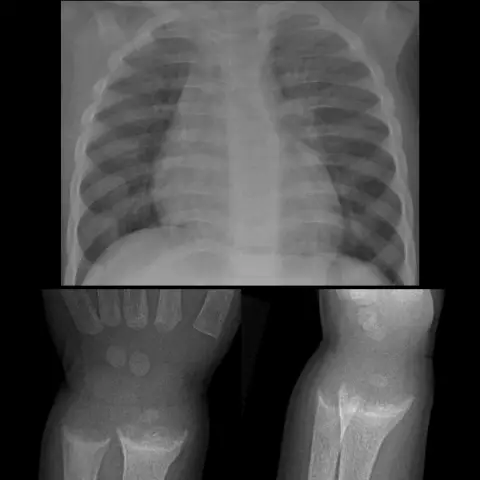- Author Curtis Blomfield [email protected].
- Public 2023-12-16 20:44.
- Last modified 2025-01-23 17:01.
Maple Syrup Disease is a genetic disease associated with a metabolic disorder of amino acids such as leucine, isoleucine and valine. Their concentration in human body fluids increases, causing poisoning, ketoacidosis, convulsions and even coma.
History

For the first time in the medical literature, maple syrup disease in adults was described in 1954 by the physician Menkes. It got its name because of the specific smell of urine in patients. To researchers, it resembled burnt sugar or tree syrup. Another more scientific name is branched acid disease.
Occurs approximately once in one hundred and fifty thousand newborns, since the mode of inheritance of this gene is autosomal recessive. The course of the disease is severe and often ends in death in childhood.
Etiology

For the development of the disease, both parents must be carriers of the defective gene,responsible for the dehydrogenase of branched-chain alpha-keto acids. In nature, this enzyme is found in protein-rich foods such as eggs, milk, cheeses, poultry, and others. The newborn develops organic acidemia, which is extremely dangerous for the nervous system.
Maple syrup disease is more common in Jews, Amish, Mennonites. This is due to the fact that they live in a closed social group, and marriages most often occur between very distant relatives, which means that the likelihood of parents having a mutated gene responsible for amino acid metabolism increases significantly.
Symptoms

Already in the second week after birth, maple syrup disease can be reliably detected. Symptoms lie in the unconventional behavior of the child: he constantly cries quietly, eats poorly, spit up often and profusely, and may even vomit. With the progression of intoxication, convulsions appear, muscle tone increases. This is manifested in stretching the child's body, as if "on a string", with legs crossed at the ankles. Up to the development of opisthotonus.
If parents continue to ignore the disease and do not call a doctor, then the next stage of the disease is a violation of breathing and consciousness. Children become lethargic, lack of initiative, fall into a stupor, and then into a coma. Neurological disorders, even with a favorable outcome, remain for life. This is the price to pay for the fact that maple syrup disease was not diagnosed in a timely manner. Photos of patients are depressing, and what is most sad, for the most partchildren are depicted on them.
Diagnosis is based on analysis of the presence of unfermented amino acids in the urine, as well as clinical manifestations.
Classification
Depending on the intensity of manifestations and the degree of inertness of dehydrogenase, several forms of the disease are distinguished:
- Classic. Shortly after the birth of an outwardly he althy baby, literally within a few days, symptoms begin to appear. First, this is a lack of appetite and refusal to breastfeed, then weight loss, periods of sleep apnea. Then single clonuses, and then clonic-tonic convulsions. Everything ends in a coma. Enzyme activity is below two percent.
- Periodic. The disease does not manifest itself in any way until six months, or even up to two years of life. The trigger is a bacterial or viral infection, vaccination, or an excessive increase in the amount of protein in food. Symptoms develop progressively. Enzyme activity - up to twenty percent.
- Thiamin dependent. In its clinical manifestations, it is similar to the previous form. The essential difference is that vitamin B1 is used in the treatment, which significantly reduces the concentration of amino acids in the urine and blood.
Treatment

Since a person enters the hospital in a state of severe poisoning, it is necessary to start treating maple syrup disease with detoxification. For this, plasmapheresis, peritoneal dialysis, transfusion of blood components, as well as forced diuresis and hemosorption are used.
After stabilization of the patient's condition, they begin to correct metabolic disorders. First of all, this is a diet with a reduced protein content, sometimes it is recommended not to breastfeed. Strict adherence to the rules of nutrition will help to avoid further damage to the nervous system.
Modern technology has made it possible to practically cure the disease of maple syrup. Science offers and puts into practice drugs that will replace the necessary amino acids. They will keep their metabolic rate within normal limits, preventing poisoning even with a normal diet.
If you follow the appropriate recommendations and go to the hospital in a timely manner, a person will be able to live a full life. Unfortunately, neurological disorders in children develop quickly, and parents do not have time to take appropriate measures.






